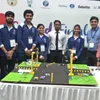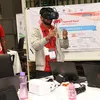Engineering students present an ocean cleaning device at the Smart India Hackathon, win Rs 75,000
Ocean cleanups will no longer be an expensive proposition with this first-of-its-kind float that sucks in waste plastic and crude oil spills. Team G-TECH, which presented the device at Smart India Hackathon, is planning a startup soon.
Plastic has clogged our seas sounding a death knell for the many creatures living in them. Recently, environmentalists removed 40 tonnes of trash from the Pacific. Combating this ocean plastic pollution is the only way we will save our planet.
Six students from CV Raman College Of Engineering, Bhubaneswar thought hard about this pervasive problem and came up with a solution that was showcased at the Smart India Hackathon 2019-Hardware edition held at IIT Hyderabad.

Team G-TECH from CV Raman College of Engineering, Bhubaneswar
G-TECH also won Rs 75,000 for their innovation to clean up our oceans.
The harsh reality
According to a study by the World Economic Forum, every year, eight million metric tons of plastic enters the ocean. This is equal to a truck full of garbage (of plastic) being dumped into the ocean every minute. If this is not upended, that number could increase to four dump trucks of plastic entering the ocean every minute.
The students - Abhishek Kumar Dubey (21), Subham Kumar Deo (21), Chandan Kumar (22), Santosh Kumar Mahatha (21), Sofia Khanam (21), Sweta Joshi (22) – were mentored by Zahid Akhtar and Vivek Kumar Lal in their project. The students are all in the final year of electrical engineering.
Leveraging technologies such as GPS module, IoT and other laws of physics, they realised the gravity of plastic pollution, and brainstormed over a solution. Combining six to seven ideas from various fields, they invented a device which helps in ocean clean-ups.
How does the innovation work?
Two main pollutants contaminate our oceans – plastic and spilled crude oil.
“We made a sequential float which is modular, with a smart-driving and monitoring unit which is flexible. It has an attachment to an electromagnetic float which collects both offshore plastic and spilled oil. This can be used in any flowing water body, rivers, etc,” says Abhishek, the team lead.

Team G-TECH
“The float (boom) will automatically take a ‘U’ shape once released at sea, and it doesn’t need electrical or battery power. It is fitted with a GPS – to track it in on the app. As the float (boom) starts moving using oceanic currents or wind, it collects trash inside an internal area of the boom. Once the boom is full, the app reflects that the coordinates are stationary. Users of the app also get a notification of this. The boom then transforms itself from ‘U’ shape to ‘O’ shape, locking the trash inside the container,” Abhishek explains.
Specified users will get specified codes with an access to the app. When the boom moves, it does so with help from the wind velocity, but when the shape changes from ‘U’ to ‘O,’ the solar panels fitted inside the boom transfer energy.
The float for plastic trash can go up to 3 metre depth and the float used for oil spills does the work at the surface level. This product can be used by different companies or governments for cleaning ocean and river plastic on a large scale, with an additional feature of collecting spilled oil. It also prevents the destruction of coral reefs.
Currently, when oceans are cleaned, generally mother ships are used to clean trash, which Abhishek feels is an expensive alternative. The USP of the product, Abhishek says, “It is a first-of-its-kind product that is modular, flexible and easy to operate.” The cost of the float depends upon its length : The 2.8 m long float for plastic collection costs Rs 2,000, and the 2.8m long float for oil spill costs Rs 7,000.
The students now plan to build their own startup, and generate revenue. “We are planning to set up dumping units in which all the collected plastic trash will be dumped on the beach. From there, plastic recycling units will transport the plastic to processing. This processed plastic will be used as raw material to make more floats.”
(Edited by Suruchi Kapur-Gomes)





1564138444749.png?fm=png&auto=format&h=100&w=100&crop=entropy&fit=crop)




